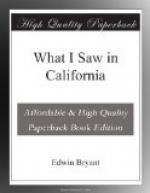On the coast, a few miles above Santa Barbara, there are, I have been told, immense quantities of pure bitumen or mineral tar, which, rising in the ocean, has been thrown upon the shore by the waves, where in a concrete state, like resin, it has accumulated in inexhaustible masses. There are, doubtless, many valuable minerals in the neighbouring mountains, which, when developed by enterprise, will add greatly to the wealth and importance of the town. For intelligence, refinement, and civilization, the population, it is said, will compare advantageously with any in California. Some old and influential Spanish families are residents of this place; but their casas, with the exception of that of Senor Don Jose Noriega, the largest house in the place, are now closed and deserted. Senor N. is one of the oldest and most respectable citizens of California, having filled the highest offices in the government of the country. One of his daughters is a resident of New York, having married Alfred Robinson, Esq., of that city, author of “Life in California.”
The climate, judging from the indications while we remained here, must be delightful, even in winter. With the exception of one day, which was tempestuous, the temperature at night did not fall below 50 deg., and during the day the average was between 60 deg. and 70 deg. The atmosphere was perfectly clear and serene, the weather resembling that of the pleasant days of April in the same latitude on the Atlantic side of the continent. It is a peculiarity of the Mexicans that they allow no shade or ornamental trees to grow near their houses. In none of the streets of the towns or missions through which I have passed has there been a solitary tree standing. I noticed very few horticultural attempts in Santa Barbara. At the mission, about two miles distant, which is an extensive establishment and in good preservation, I was told that there were fine gardens, producing most of the varieties of fruits of the tropical and temperate climates.




